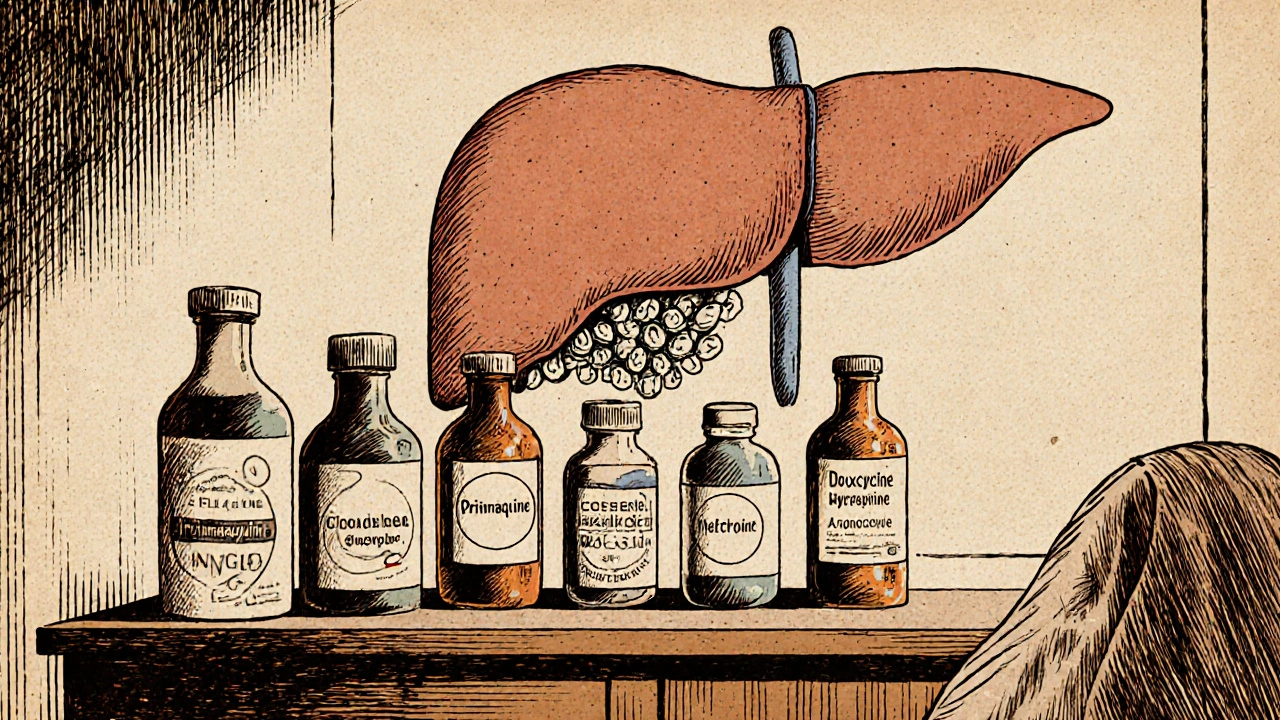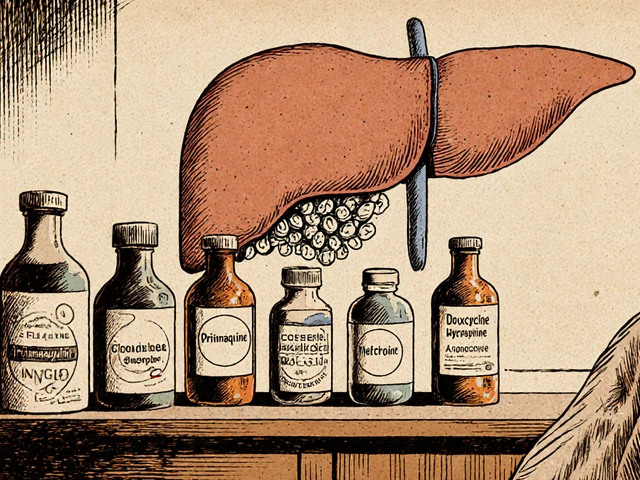Antimalarial Selection Tool
Select Your Input Factors
Choose parameters that apply to your situation to get personalized antimalarial recommendations.
Select your input factors to see recommendations
This tool will help you select the most appropriate antimalarial based on your specific situation.
Quick Summary
- Primaquine is the only drug that kills dormant liver stages (hypnozoites) of Plasmodium vivax and Plasmodium ovale.
- It requires a normal G6PD level; otherwise, severe hemolysis can occur.
- Alternatives like chloroquine, mefloquine, doxycycline, and atovaquone‑proguanil cover blood‑stage parasites but not hypnozoites.
- Cost and side‑effect profiles differ widely - primaquine is inexpensive but has higher risk in G6PD‑deficient patients.
- Choosing the right drug hinges on species, travel region, patient genetics, and safety concerns.
What Is Primaquine?
Primaquine is a synthetic 8‑aminoquinoline antimalarial that was first approved in 1952. It is primarily used for the radical cure of P. vivax and P. ovale infections because it can clear dormant liver forms called hypnozoites. In the United States, primaquine is a prescription‑only medication and is available in 15mg and 30mg tablets.
How Primaquine Works
Primaquine targets the parasite’s mitochondrial electron transport chain in both liver and red‑blood‑cell stages. By disrupting the parasite’s energy production, it eliminates hypnozoites that can reactivate weeks or months after the initial infection. This “radical cure” prevents relapses, a key advantage over drugs that only treat the blood stage.
When to Use Primaquine
Ideal scenarios for primaquine include:
- Patients diagnosed with P. vivax or P. ovale malaria who need a full cure.
- Travelers returning from endemic regions where these species predominate.
- Individuals who have completed an initial blood‑stage therapy (often chloroquine) and require follow‑up to prevent relapse.
Because primaquine can cause oxidative stress to red blood cells, a quantitative G6PD test is mandatory before prescribing.

Common Alternatives
Several other antimalarials are used for prophylaxis or treatment, each with its own niche.
- Chloroquine - effective against P. falciparum in regions without resistance, cheap, but does not clear hypnozoites.
- Mefloquine - long‑acting weekly prophylaxis, good for multidrug‑resistant areas, but can cause neuropsychiatric side effects.
- Doxycycline - daily tablet, works well in resistant zones, contraindicated in pregnancy and children under 8.
- Atovaquone‑proguanil (Malarone) - short‑course daily regimen, well‑tolerated, but relatively expensive.
Side‑Effect Profiles at a Glance
Below is a side‑by‑side look at the most common adverse events for each drug.
| Drug | Most Frequent Side Effects | Serious Risks | Contraindications |
|---|---|---|---|
| Primaquine | nausea, abdominal pain, insomnia | Acute hemolysis in G6PD‑deficient patients | G6PD deficiency, pregnancy (first trimester) |
| Chloroquine | headache, dizziness, visual disturbances | Retinal toxicity with long‑term use | Known chloroquine resistance, severe liver disease |
| Mefloquine | nausea, vivid dreams, anxiety | Severe neuropsychiatric events, seizures | Psychiatric history, cardiac arrhythmias |
| Doxycycline | photosensitivity, esophagitis, gut upset | Severe esophageal ulceration if not taken with water | Pregnancy, children < 8years, severe liver disease |
| Atovaquone‑proguanil | abdominal discomfort, headache, metallic taste | Rare severe hepatic injury | Severe renal impairment, known hypersensitivity |
Pros and Cons: Primaquine vs. Alternatives
Primaquine shines when you need to eradicate hypnozoites - no other standard drug does that. It’s inexpensive (around $0.30 per 15mg tablet) and works with a short 14‑day course after blood‑stage treatment. The biggest drawback is the mandatory G6PD test and the risk of hemolysis.
Chloroquine is cheap and easy to take but useless against relapsing vivax malaria. Mefloquine’s weekly dosing is convenient, yet the neuro‑psychiatric warnings turn many patients away. Doxycycline offers broad coverage, but daily dosing and photosensitivity limit its use in hot climates. Atovaquone‑proguanil is well‑tolerated and fast‑acting, but its price (≈$10-$12 per tablet) makes it a stretch for long‑term travelers.
Decision Guide: Choosing the Right Antimalarial
- Identify the parasite species. If P. vivax or P. ovale is confirmed, primaquine (or tafenoquine) is required for radical cure.
- Check G6PD status. Normal activity → primaquine possible. Deficient → skip primaquine, consider chloroquine for blood stage and monitor for relapse.
- Consider travel region. Areas with high chloroquine resistance demand mefloquine, doxycycline, or atovaquone‑proguanil for prophylaxis.
- Assess patient tolerance. History of depression or seizures rules out mefloquine; pregnancy eliminates doxycycline and primaquine (first trimester).
- Factor in cost and access. If budget is tight, chloroquine or primaquine are cheapest; for high‑risk travelers who can afford it, atovaquone‑proguanil may be preferred.
This flow helps clinicians and travelers quickly narrow down the best option.
Safety Considerations Beyond G6PD
Pregnancy safety varies. Primaquine is classified as CategoryC (risk cannot be ruled out) and is generally avoided in the first trimester. Doxycycline is contraindicated throughout pregnancy due to tooth discoloration in the fetus. Mefloquine’s safety data are mixed; many providers avoid it in the first trimester as well.
Renal or hepatic impairment can affect drug metabolism. Atovaquone‑proguanil requires dose adjustment in severe renal failure, while chloroquine accumulates in the liver and may cause toxicity if liver function is compromised.
Cost and Accessibility in 2025
Below is an approximate 30‑day cost for a standard prophylactic regimen in the United States (prices from major pharmacies, 2025 data).
| Drug | Unit Cost (USD) | Total Approx. Cost | Prescription Required? |
|---|---|---|---|
| Primaquine | $0.30 per 15mg tablet | $6-$9 | Yes |
| Chloroquine | $0.10 per 250mg tablet | $3-$5 | Yes |
| Mefloquine | $0.80 per 250mg tablet | $24-$30 | Yes |
| Doxycycline | $0.50 per 100mg tablet | $15-$20 | Yes |
| Atovaquone‑proguanil | $10 per tablet | $300-$350 | Yes |
Insurance coverage varies; many plans cover chloroquine and primaquine, while atovaquone‑proguanil often requires a higher copay.
Frequently Asked Questions
Can I take primaquine if I’m pregnant?
Primaquine is generally avoided during the first trimester because animal studies suggest a risk of fetal harm. In later pregnancy, it may be used only after a careful risk‑benefit discussion and confirming normal G6PD activity.
How long does primaquine treatment last?
The standard radical cure regimen is 0.5mg/kg/day for 14days after completing the blood‑stage therapy. Some regions use a weekly 0.5mg/kg dose for eight weeks, but daily dosing is most common.
Do I need a G6PD test before every primaquine dose?
Yes. A quantitative G6PD assay is the safest way to rule out severe deficiency. Point‑of‑care tests have improved accuracy in 2025, making screening more accessible.
Is there an alternative to primaquine for radical cure?
Tafenoquine, a single‑dose 8‑aminoquinoline, offers similar radical cure but also requires G6PD testing and is contraindicated in pregnancy. It’s priced higher than primaquine but may improve compliance.
Which drug is best for travelers to a chloroquine‑resistant area?
Mefloquine, doxycycline, or atovaquone‑proguanil are the go‑to options. The choice depends on personal tolerance, pregnancy status, and budget.
Next Steps for Patients and Clinicians
If you suspect malaria, confirm the species with a thick‑blood smear or rapid diagnostic test. Once P. vivax or P. ovale is identified, order a quantitative G6PD test before prescribing primaquine. For prophylaxis, match the traveler’s itinerary with the current resistance map and select a drug that aligns with health history and cost considerations.
Keep a copy of the treatment plan, side‑effect checklist, and follow‑up dates. Early detection of hemolysis - dark urine, rapid fatigue, shortness of breath - should trigger immediate discontinuation of primaquine and emergency care.
Staying informed about evolving resistance patterns and updated WHO guidelines (2024 revision) will ensure you’re always offering the safest, most effective regimen.








Oliver Harvey October 15, 2025
Wow, another brilliant masterpiece on primaquine, just what the world needed. I’m thrilled to see yet another list of side‑effects that could have been summarized in a single bullet. The author managed to cram more technical jargon into a paragraph than a pharmacology textbook. Really, who doesn’t love reading about hemolysis risk while waiting for their coffee? And the table? A masterpiece of alignment, except for the occasional missing closing tag. Let’s not forget the heroic reminder that G6PD testing is mandatory, because why make life easy? The cost comparison reads like a discount retailer’s flyer, which is oddly comforting. I’m also impressed by the flawless use of the word ‘radical cure’ without a single hyphen – true brilliance. The section on pregnancy safety could have been a haiku, but the author chose prose, bravo. If you’re wondering about dosing, the article provides a recipe more detailed than a cooking show. The inclusion of an emoji‑like table border really adds that personal touch we all crave. Honestly, I’m considering renaming my cat ‘Primaquine’ after this literary tour de force. All in all, a solid read for anyone who enjoys the smell of academia mixed with cheap tablets. Just one minor gripe: the occasional misuse of ‘its’ versus ‘it’s’ – but who’s counting? Keep up the good work, and don’t forget to smile :)
Ben Poulson October 22, 2025
Dear colleagues, I commend the thorough exposition of primaquine’s pharmacodynamics and its indispensable role in eradicating hypnozoites. The comparative table, while extensive, could benefit from standardized units across all agents. Moreover, the discussion of G6PD testing underscores a pivotal safety consideration that must not be overlooked in clinical practice. I would further suggest integrating recent WHO guidelines regarding tafenoquine as an alternative radical cure. In conclusion, the manuscript provides a valuable resource for clinicians navigating antimalarial therapy selection.
Anna Graf October 29, 2025
Life is full of hidden battles, just like vivax hiding in the liver. Killing those silent foes feels like finding meaning in a chaotic world. Primaquine, then, becomes a small beacon of hope, reminding us that even the unseen can be confronted.
Lindy Fujimoto November 5, 2025
Ah, the drama of a drug that can both save and destroy! 😱 One moment you’re a hero preventing relapses, the next you’re a villain causing hemolysis in the unsuspecting. It’s almost poetic, isn’t it? The elegance of a 15‑mg tablet wielded like Excalibur, yet demanding the sacred G6PD test as a sacrificial rite. 🌟 In my humble opinion, the medical community should treat primaquine with the reverence of a priceless artifact, not just another prescription. 😏💊
darren coen November 12, 2025
That’s a vivid description, and it really hits home.
Noah Bentley November 19, 2025
Okay, let me break this down for the uninitiated: primaquine works, but only if you bother to test G6PD first – because apparently common sense isn’t common enough. Also, “radical cure” isn’t a Yelp review, so maybe drop the buzz‑words next time. And seriously, who thought “dose for 14‑days” needed a comma? Just saying. :)
Ogah John November 26, 2025
We all know that navigating antimalarial choices can feel like walking a tightrope over a swamp of side‑effects. Yet, by grounding ourselves in solid evidence and patient‑centered discussions, we can turn that wobble into steady progress. Keep asking the tough questions, and remember: the best cure is one that balances efficacy with safety.
Kelvin Murigi December 3, 2025
From a pharmacological perspective, the article correctly highlights primaquine’s unique activity against hypnozoites, but it underrepresents the importance of adherence monitoring during the 14‑day regimen. In practice, clinicians should employ reminder systems and verify G6PD results before dispensing the medication. Additionally, emerging data on tafenoquine suggest a viable single‑dose alternative for patients who can tolerate it, which warrants inclusion in future comparative tables. Finally, cost‑effectiveness analyses should factor in the expense of hemolysis management when prescribing to G6PD‑deficient populations.
ahmad matt December 9, 2025
Honestly this write up feels like a rushed Wikipedia copy paste no depth no nuance the tables are cluttered the language is bland and the author missed the chance to discuss newer 8‑aminoquinolines like tafenoquine which could have added real value also the cost section ignores insurance rebates making it look cheap when it isn’t just another superficial overview